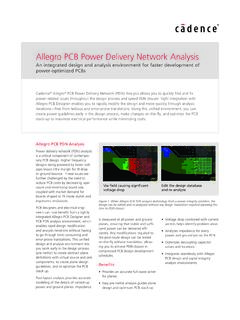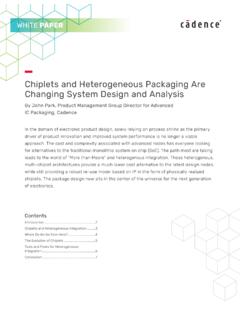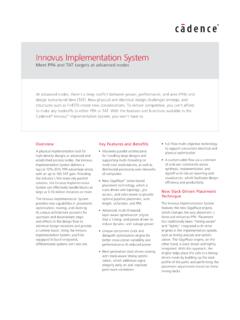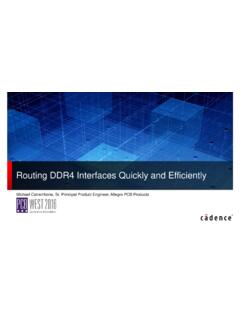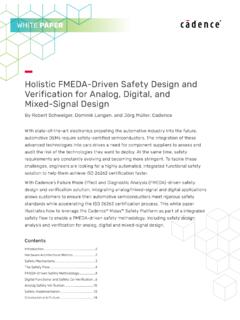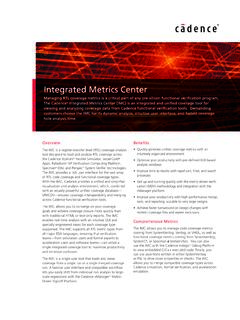Transcription of DO-254 Explained
1 IntroductionIf you re reading this paper, you are likely struggling to understand the DO-254 specification1, what this standard means, what it takes to comply, and how much more time and cost you should allocate to meet this standard. This white paper, the first in a series of white papers, will attempt to explain the standard, the concepts and reasoning behind the standard, and the basic steps and components necessary to successfully complete the project and achieve DO-254 to several industry sources, a project meeting DO-254 can cost to 4X more than the same project without DO-254 . Why the extra expense? Usually the 4X cost increases come from a lack of DO-254 experience, further compounded when current methodologies and processes are significantly lacking compared to a structured flow conforming to DO-254 . In addition, a lack of adequate project planning and evidence that the overall process was followed can lead to audit failures causing design and verification re-work and additional justification headaches.
2 However, there are ways to create a DO-254 -approved project without breaking your schedule or budget. A well planned and executed DO-254 project will almost certainly take more time and money than a non- DO-254 project, but there are ways to reduce these costs to manageable levels. The first step in the process is becoming better educated in the underlying concepts and components of DO-254 . What Is DO-254 ? Simply stated, DO-254 is a requirements-driven process-oriented safety standard used on commercial electronics that go into aircraft. (Conceptually speaking, this standard applies to all electronics in anything that flies or could crash and pose a hazard to the public.) DO-254 ExplainedBy CadenceThis white paper, the first in a series of DO-254 -related white papers, will explore the high-level concepts and activities within the DO-254 Design Assurance guidance for Airborne electronic Hardware specification , why they exist, and what they mean.
3 In this paper, we will explore the safety-related concepts of requirements traceability, design assurance levels, the overall DO-254 -compliant flow as documented in the spec, and several other aspects that might not be well documented but are critical to project DO-254 spec is available on the RTCA website: ..1 What Is DO-254 ? ..1 Certification Officials ..5 I Still Don t Get ..5 Other Design Considerations ..6 Conclusion ..6 For Further Information ..6 Based on their safety criticality, different parts of the aircraft are designated different Design Assurance Levels, or DALs for short (Figure 1). A system that is highly critical will receive a higher DAL, with DAL A reserved for the most critical systems. This criticality is determined by a safety assessment of the aircraft and interacting systems to determine the required target failure rate. For DO-254 , the difference between meeting DAL A and DAL B is minimal, so they are frequently referred to as DAL A/B in various writings, including aspects of this AssuranceLevel (DAL)DescriptionTarget SystemFailure RateExample SystemLevel A(Catastrophic)Failure causescrash, deaths<1 x 10-9 chanceof failure/flight-hrFlight controlsLevel C(Major)Failure may causestress, injuries<1 x 10-5 chanceof failure/flight-hrBackup systemsLevel B(Hazardous)Failure may causecrash, deaths<1 x 10-7 chanceof failure/flight-hrBraking systemsLevel D(Minor)Failure may causeinconvenienceNo safety metricGround navigationsystemsLevel E(No effect)No safety effect onpassengers/crewNo safety metricPassengerentertainmentFigure 1.
4 Design Assurance Levels (DALs)Because DO-254 is a process-oriented standard, it s important to understand the overall flow, shown in Figure 2 (and in Figure 5-1 of the DO-254 specification ), expected by a DO-254 certification (Section 4)Derived RequirementsDetailed DesignConceptualDesignRequirementsCaptur eImplementationProductTransitionSupporti ng ProcessesHardware DesignProcesses (Section 5)System Processes (Section 2)Manufacturing ProcessesSection Validation and Verification Processes (Section 6) Configuration Management (Section 7) Processes Assurance (Section 8) Certification Liaison (Section 9)Figure 2: DO-254 flowLet s walk through this process to briefly explain each component of this is a critical piece of the DO-254 certification. It s important to document your project flow up-front and approach your certification official to gain their approval early in the project.
5 Typically the high-level plans are documented in the Plan for Hardware Aspects of Certification (PHAC commonly pronounced as pea-hack ). This plan should include all aspects of your project and how you will meet the DO-254 requirements. ExplainedRequirements Capture and ValidationThe DO-254 specification utilizes a requirements-based design and verification approach. This means that the entire hardware project revolves around a formal set of high-level requirements. Before any RTL is written, each of these requirements must be written down, given a unique reference name, and reviewed for a variety of criteria including understandability, testability, verifiability, DesignAt the conceptual design stage, a larger design is broken down into smaller, more manageable components. This might be thought of as a high-level block diagram. (Note: For a sufficiently simple system, the conceptual design step may be skipped or merged with the Detailed Design step.)
6 Detailed DesignThis step is where the real design work takes place. For each component detailed in the conceptual design, the RTL hardware design should implement each and every requirement for that component. Each high-level requirement should be traced to the top-level RTL module implementing that requirement. This traceability can happen in a variety of ways, and it is up to the implementation team to determine the desired approach. Separately, the verification team should create verification tests to verify that each requirement has been met by the RTL, including a message to the log file showing the expected result, the actual result seen in the simulation, and the result (pass/fail). Each test must also be linked to the high-level requirement, including the pass/fail criteria (all must pass, obviously). Constrained random testing can also be used for more complex designs; however, special care must be used to create additional verification coverage components tied to all the requirements.
7 If you are using an advanced verification tool such as the Cadence vManager Metric-Driven Signoff Platform, then the additional traceability automation needed is built into the tool. This is the device you want to buildMake sure you are goingto build the right device(validate requirements)Build the device(controlled/repeatable flow)Make sure the device meets its requirementsTreceability is CriticalRequirements(New or Change)RequirementsValidationDeviceImple mentationDeviceVerificationFigure 3: Requirements-driven flow, including traceabilityImplementationThe implementation process is obviously technology specific. For an RTL-based design (such as an FPGA or ASIC), the implementation step includes the synthesis process of converting RTL into actual technology-specific gates. For an FPGA, this also includes creating the programming file to load into the FPGA. For an ASIC, this step includes the backend design/verification steps.
8 Here, the main point is to follow the process detailed in your PHAC document up-front. The DO-254 specification typically allows you to remain somewhat high level while documenting your activities during implementation (especially during ASIC implementation). This is due to the fact that there will be significant testing performed on the final design. Production TransitionThis is the final stage, when you are transferring your design over to manufacturing. Typically, this ensures such aspects as: How can you be sure you re using the correct version of the programming file during the manufacturing process? (FPGA) Explained How can you be sure you re using the correct part? (ASIC and FPGA) Have you properly handled any errata for the device? portion of the process can be quite complex, and can involve several systems flowing back into the requirements process tools (such as IBM DOORS), and is critically important to ensure the final system receives the results of all AssuranceAlong with your DO-254 -compliant plan, you should also document how you will ensure you will meet this plan, typically documented in a Process Assurance or Quality Assurance plan.
9 This plan documents who will be designated as the process assurance person or organization to double check that your PHAC and other plans are followed, and how this checking will be performed. It s important to realize that you must be able to prove that this checking happened, typically by creating a paper trail of internal meetings, reviews, internal audits, etc. Typically, a DO-254 certification official wants this process assurance performed by a separate qualified person or organization (for example, someone knowledgeable about design/verification, but not someone on this design or verification team). This person/organization must also be given the authority to carry out this process, and be provided access to the engineers and design environment. Configuration ManagementIn addition to the Process Assurance plan, you should also create a Configuration Management (CM) plan.
10 In this plan, you will document how you will ensure the development process and artifact generation process is repeatable. This typically includes a revision control and bug tracking systems for all design/verification files, as well as all documentation and artifact documents. The DO-254 specification refers to the importance of tracking all design artifacts throughout the design process. Certification officials understand that design and verification files will go through many iterations. However, once they are stable, you are expected to baseline the design. In typical commercial electronics, this is analogous to a design freeze a point in a schedule when subsequent changes are closely controlled and documented, as shown in Figure Process MilestonesBaselineStartInitialDesignDone Code FreezeReleaseSandboxHC2HC1 Little Control NeededRevision ControlRevision Control,and Bug TrackingFigure 4: Design process and baselinesCertification LiaisonTypically, a single person is selected as the main communication point for the certification officials.
